 |
||
|
||
| ||
Recently I got a preproduction sample of the AMD Mobile Athlon 64 based notebook PC. I didn't have much time on examination of this wonder of engineering, and I will briefly share my impressions. Why briefly? First of all, because that was a preproduction sample, and secondly I'm not an expert in processors, and it's not for me to judge advantages of the architecture. Here you can find out what the professionals think about it. That is why we will be mostly reviewing the new mobile processor.  The notebook looks standard for the Mitac platforms both inside and outside. There are all necessary connectors (4 USB 2.0, IEEE1394 ports, RJ-45 & RJ-11, parallel, IR ports, monitor output, audio ports, card reader, PC Card connector). A wireless network is optional, and this sample doesn't have it. Also, it has QSI SBW-242 DVD/CD-RW drive and Fujitsu MHT2060AT hard drive. But the most interesting component is hidden under the cover in the upper right-hand corner (on the photo):  The powerful cooler with a centrifugal blower  is installed over the processor. 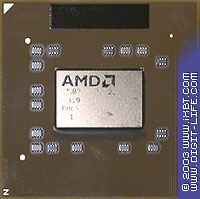 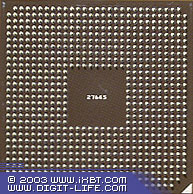 Unfortunately, the most part of the marking remained on the thermal grease: 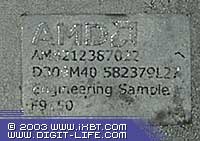 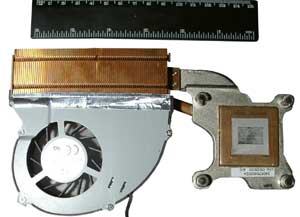 As I can understand from the marking, the processor is also a preproduction model :). The notebook weighs about 2.5 kg. Judging by a powerful battery and a bulky cooler AMD's new processor is not a competitor for the Intel Pentium M. It's not that light and slim. Well, the mobile Athlon 64 differs from the desktop one only in a metallic cover on the die, that is why the Mobile Athlon 64 3000+ consumes up to 85 W. This particular sample consumes 81.5 W. As a result, the AMD Mobile Athlon 64 is targeted at powerful notebooks like DTR (desktop replacement) and universal models, i.e. the models which actually work in the steady-state conditions and which, if necessary, can function in the offline mode. Hence its main competitor will be the Intel Pentium 4-M. Now let's turn it on (though first we tested it then disassembled). The video card is ATI RADEON M9600 64MB, the most powerful mobile graphics controller. In combination with the 15" matrix of 1400x1050 it makes a solid base for the processor. So, what's about the CPU? 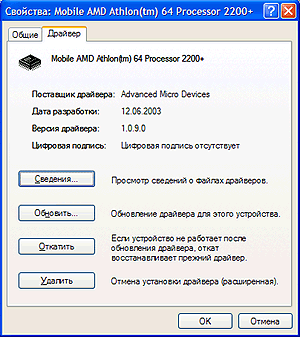 AMD Mobile Athlon 64 2200+. The rating again... What is its actual clock speed? Here is what the CPU-Z shows us (power supply mode - Portable/Laptop, line supply, Microsoft Windows XP Professional SP1). 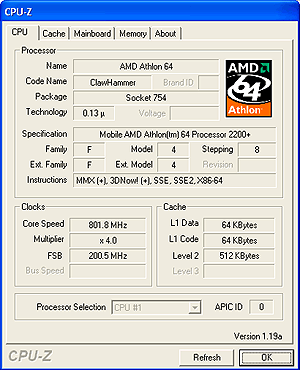 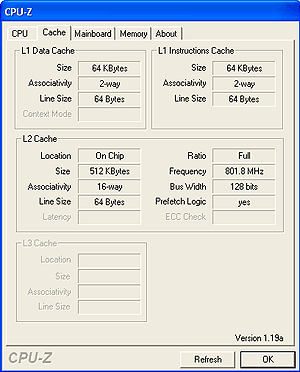
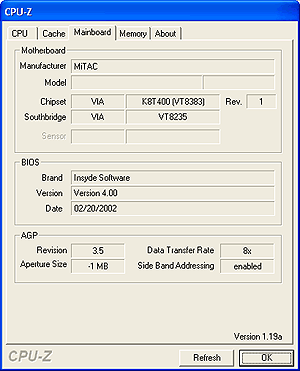 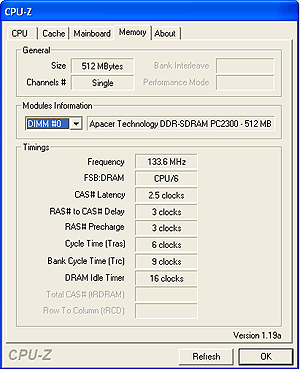 Wow, the guys at AMD are not modest at all. The processor clocked at 800MHz has the rating of 2200+!!! The memory bus speed is low as well. I wonder how the 1.8GHz processor will be rated? But that's the preproduction sample only. The Mobile Athlon 64 started the series from 1800 MHz (rating 3000+) with the L2 cache of 1MB. Some time ago I also tested a preproduction sample of the Pentium 4-M based notebook with the ATI RADEON M9600 64MB card (SiS M651 chipset), though the clock speed was 2.5 GHz. The test results of this notebook plus those of the ASUS L4H with the Intel Pentium 4-M 2.2GHz CPU onboard will be used for comparison (though the latter has the integrated graphics in SiS M650). The scores do match the rating. The clock speed doesn't fall down in the offline mode only. Let's try to make it out why. The CPU-Z utility is started. Let's address the disc. What's this? The frequency jumps up to 900MHz. What if we run more resource hungry applications? 1200, 1700, 1800MHz!!! It turns out that AMD loves their Cool'n'Quiet technology (voltage and clock speed dynamic management) so much that it works even when the notebook gets line power supply. By the way, this technology is supported in all processors with the AMD64 core (the BIOS support is also required). Well, power saving is the world-wide slogan today. As a result, our preproduction sample of the mobile Athlon 64 differs from the production processor only in the L2 cache size. Now let's switch power to the Home/Office Desk mode: 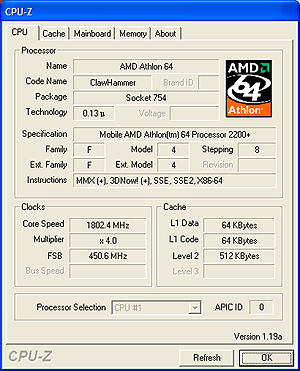 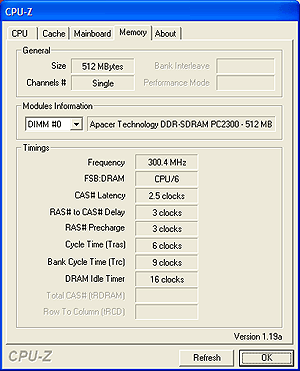 Well, that's right. But the FSB of 450MHz and memory bus clock of 300MHz look confusing, though it can be a software problem that the system performance is interpreted not very correctly. The clock speed is correct since the AMDClk utility proves it. It really is 1.8GHz. Well, it's better but, still, we have to test anew. Fortunately, the graphics test scores haven't changed much (they even worsened a bit within the measuring inaccuracy), but the SYSmark scores are completely different: At the maximum clock speed the Athlon Mobile 64 beats the Intel Pentium 4-M 2.5GHz in the test which was recently criticized by AMD as they considered it adapted for Intel's processors. The rundown time of the notebook (in the Portable/Laptop mode) was 189 minutes in the Productivity workload pattern of MobileMark 2002 and 201 minutes in the Reader workload pattern. The scores are pretty good, but remember that the battery is also capacious (Battery Capacity 97680 MWh). The competitors have much weaker batteries. The next test estimates performance in the offline mode. Performance in this mode generally depends on the BIOS settings, that is why the fact that this is a preproduction sample can have a great effect. Anyway, this system performs quite well. So, the AMD Mobile Athlon 64 based notebook PC works well. But what about games? First comes the 3DMark. The ASUS L4H is left aside this time. The Athlon 64 is ahead in the low resolutions and a little behind in the high ones. In general, the scores can be considered equal. In the 3DMark03 Pro the Intel is definitely ahead. AMD's processor has a low CPU Score - 176 against Intel's 422. I don't know why. If you want to find it out have a look at the detailed data. Now the games: The Mobile Athlon 64 is a bit ahead. In the low resolutions the advantage is greater. However, the situation is similar to the desktop processors. In the Serious Sam 2 the scores of the new AMD processor are awful, probably because of the Mobile Athlon 64 sample itself because the desktop version has different scores and because the mobile Athlon 64 differs from the desktop one only in a metallic cap covering the die. The speed can't be twice higher. The reinstallation of the drivers (CATALYST Windows XP 3.7) doesn't help, as well as an installation of another version. All OpenGL parameters are set to Speed. Nothing helps. Well, that's the preproduction sample. Summary. ConclusionI've got a positive impression of the AMD Mobile Athlon 64 based notebook.
Before that I was skeptical about AMD's mobile solutions. Let's wait for
the production model to see the final performance.
Nikolai Dorofeev (niko@ixbt.com)
Write a comment below. No registration needed!
|
|
Platform · Video · Multimedia · Mobile · Other || About us & Privacy policy · Twitter · Facebook
Copyright © Byrds Research & Publishing, Ltd., 1997–2011. All rights reserved.